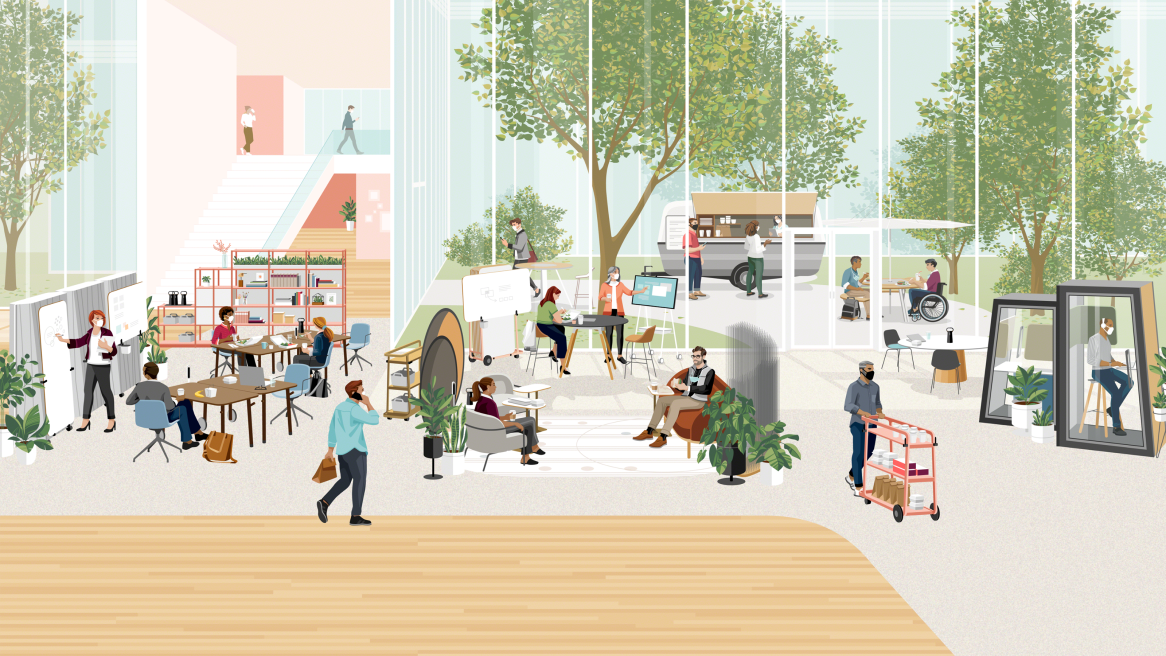Kickstart Your Return to the Office
Create the buzz people missed with new ideas for high energy collaboration and social spaces
Whether you like working from home or not, everyone has experienced the feeling of isolation during the pandemic. People also struggled to collaborate while apart. The shift to remote work caused millions of workers to suffer from loneliness and isolation and it’s had a negative impact on their engagement, productivity and wellbeing.
Many people can’t wait to return to the office and work side-by-side with their colleagues again and organizations are taking every precaution to make sure workplaces are safe when people do come back. But what if these precautionary measures make the office feel sad and even more isolating than working from home?
“We experienced this ourselves,” says Gale Moutrey, vice president of Workplace Innovation + Brand Management, Steelcase. “When some people returned last summer, we retrofitted our workplace with diverse safety measures and implemented new protocols for safe behaviors. But the effect ended up feeling stressful for some people and some spaces looked a little sad because of distancing measures, rather than feeling the buzz or energy we were used to. Gradually, we saw a number of people — who really wanted to be there — retreat and work at home.”
“We are looking at space very differently. It will be a really great harmony between space, food and technology — a seamless and frictionless experience for people.”
Anthony GargiuloSenior Vice President, Compass Group
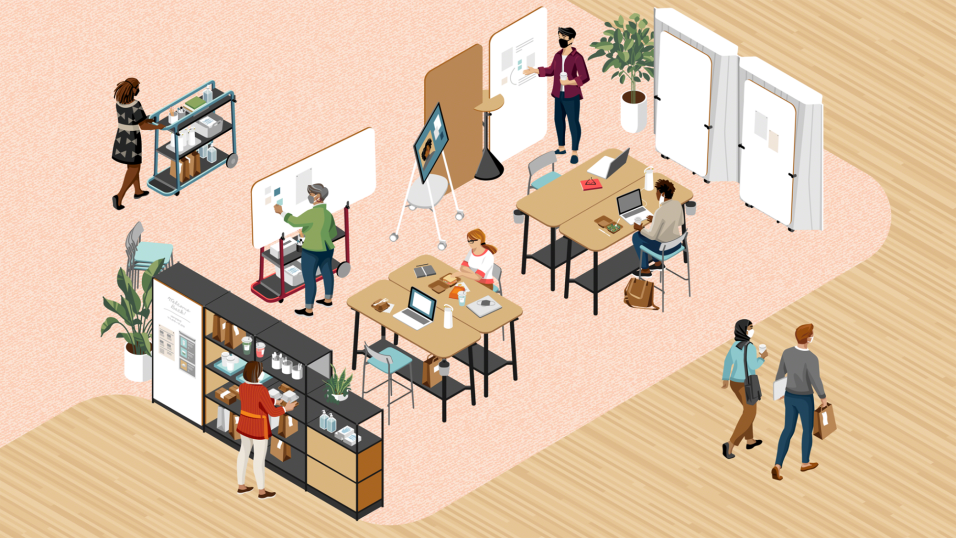
A First Step: Create a Social Hub
Over 50% of companies plan to pilot new spaces as part of their return to the office this year, and a company’s cafe is a good space to start experimenting. These spaces often sit empty parts of the day because they are typically used just for dining, individual work or small meetings. By looking at underutilized spaces in new ways, cafes can be redesigned as social hubs that will inspire people and provide high-performing settings where they can reconnect with their colleagues, as well as collaborate effectively.
We Can Help
Experiment with new ways of working by creating a pilot experience and learn more about other ways we can help to get your workplace ready.
Steelcase is currently experimenting with its WorkCafé at the Learning and Innovation Center (LINC) in Grand Rapids, Michigan. Using flexible furniture elements, and without making any expensive architectural changes, the new spaces can be quickly implemented and assets can be easily redeployed. It’s a low risk, high gain experiment, says Moutrey.
The redesigned space builds an infrastructure for cultivating a sense of community that has been difficult to create while people have been exclusively remote. A range of flexible settings with different privacy levels turns the space into a vibrant hub where different modes of work can happen simultaneously – collaboration, informal social interactions, learning and even focus work. The addition of open collaboration settings allow people to safely and comfortably connect while moving around easily. Tools such as accessible power, mobile whiteboards and digital collaboration devices make the spaces high-performing with a social, informal vibe. Employee feedback will be collected for ongoing testing and iteration.
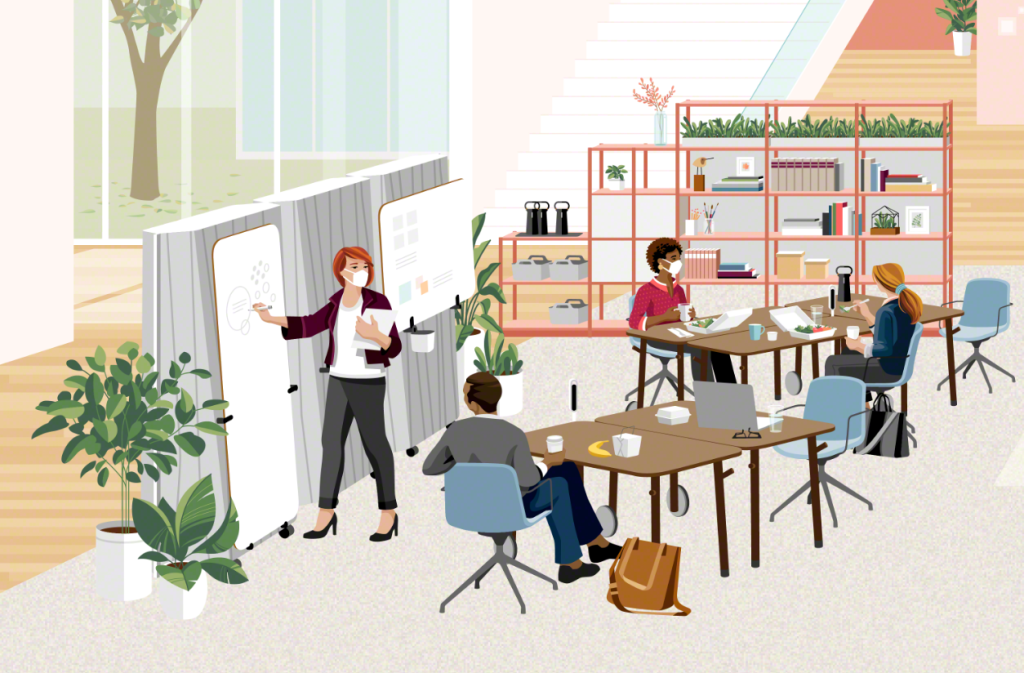
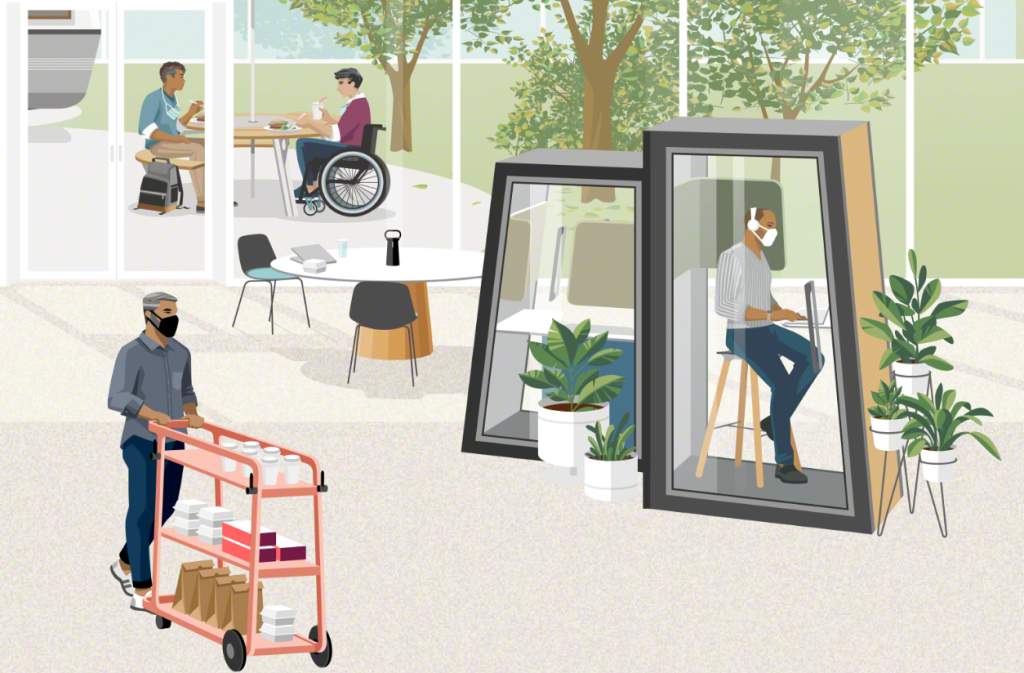
Working together with Compass Group, Steelcase is also experimenting with new ways to provide nourishment and how to do “a better job of moving food through space rather than having people move to get food,” says Anthony Gargiulo, senior vice president, Design Innovation & Transformation at Compass Group North America. “It’s going to be critical to give people more control over their entire experience — how, where and when they want to order food, where and when they want to eat, and who they want to eat with. They will expect full control over that experience so they can feel safe and secure,” says Gargiulo.
These high-performing spaces provide settings for both individual and group work, as well as inspiring spaces for people to connect with colleagues, share a meal or rejuvenate. Mobile elements such as screens and carts give teams the ability to adapt the space to meet their needs on demand. Technology tools such as mobile large-scale devices support hybrid collaboration. Mobile power allows individuals and teams to work anywhere and a variety of postures allows people to move easily and choose how they want to work.
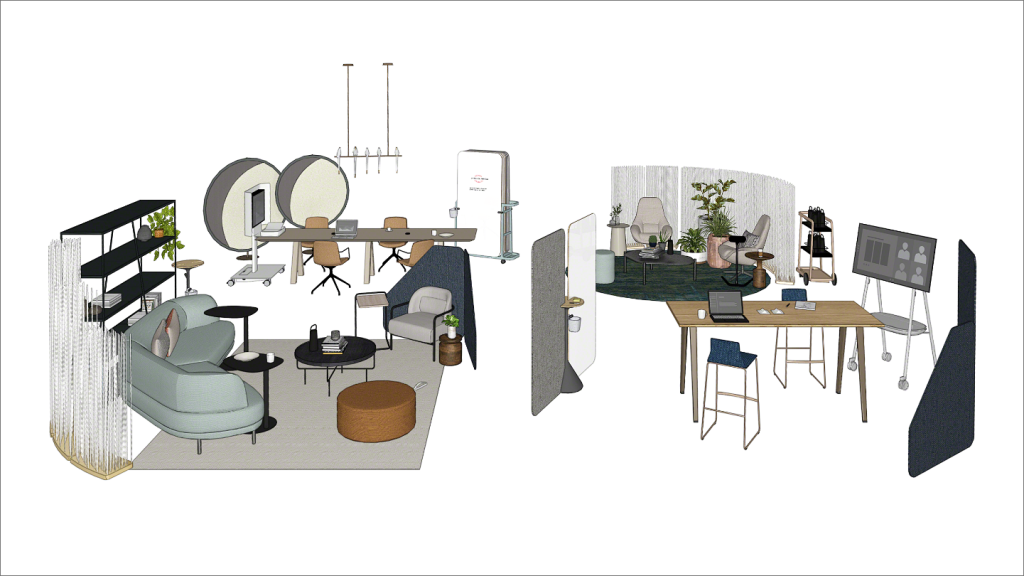
This space is for individuals looking for performance to work throughout the day. Its adjacency to meeting spaces is ideal to wrap up or extend meetings. Flexible digital and analog tools allow content sharing. Worksurfaces and comfortable seating easily support meals and coffee breaks. User-movable privacy and boundary elements are provided throughout the space.
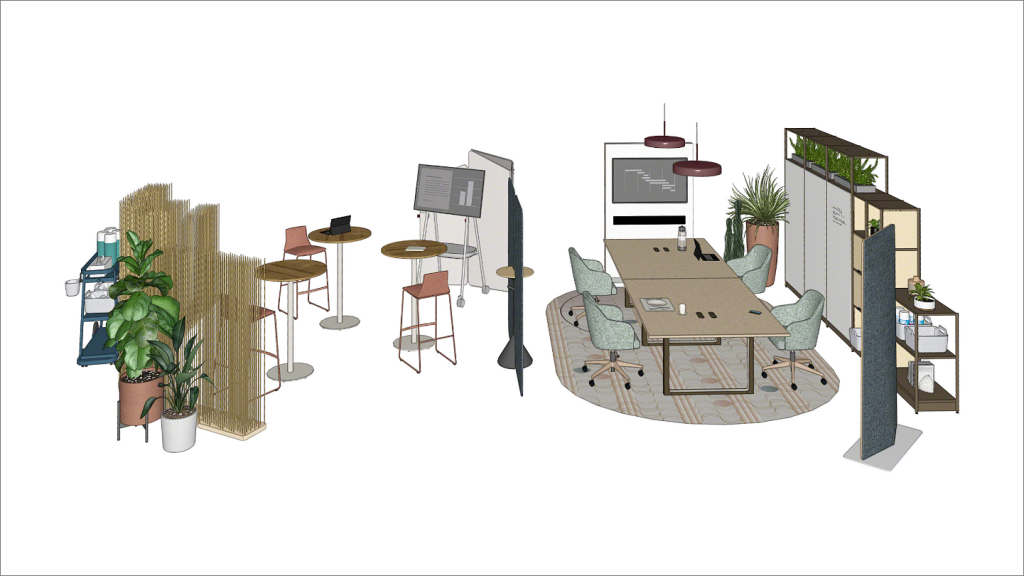
This space includes diverse settings to support dining as well as socializing or collaboration. Space can easily flex to support two separate groups, or one larger group as needed. Moveable screens and the Steelcase Flex Active Frames provide visual, acoustic and territorial privacy — people can adjust the space to provide the level of comfort they require.
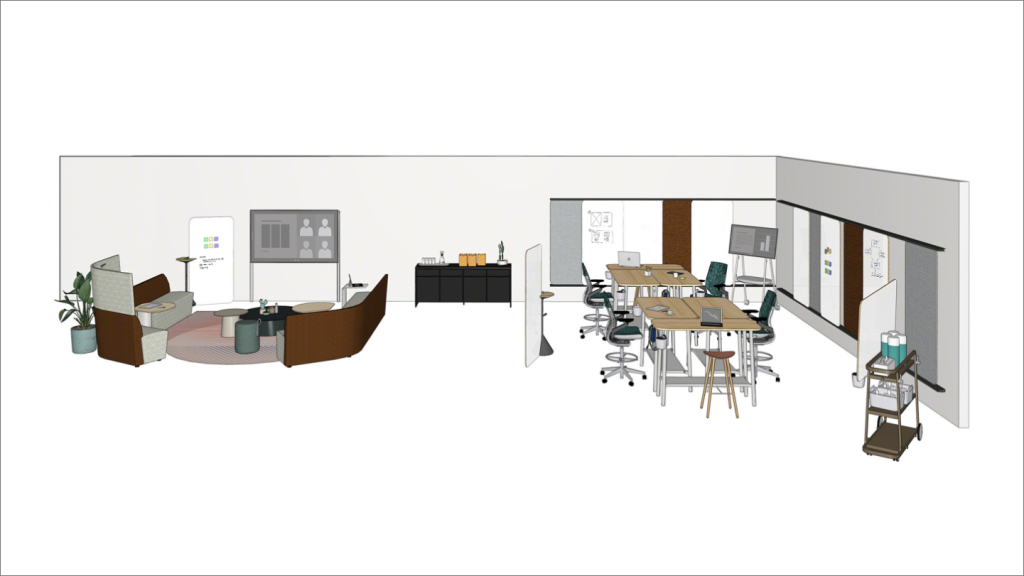
This flexible team space supports generative collaboration. It provides digital and analog collaboration tools and supports a variety of postures and work modes that can be used for a day or the entire week. Teams can easily shift between casual share-outs to iterative work sessions, or the space can be used by two teams concurrently.
Bringing Furniture and Food Together
Food plays a new role — sharing meals is a key part of nurturing relationships and the experience fuels both the body and the brain. Organizations should think beyond simply providing lunch or snacks, and create food experiences that are blended with work and bring people together.
Instead of a typical cafe model, Compass suggests designing micro food experiences throughout an entire facility to create more of a local, neighborhood feel to the overall experience. “What we’re doing with Steelcase by bringing food and furniture together is very powerful,” says Gargiulo. “How can we give space more meaning? How do we leverage it all day, not just for three hours when people are dining? We are looking at space very differently. We’re looking at it more as a series of experiences that just happen throughout the day, all day. When done well, it will be a really great harmony between space, food and technology — a seamless and frictionless experience for people.”
Compass is experimenting with new ways to deliver food that give people more choices:
- Food can be pre-ordered and prepaid using an app.
- People can request to pickup or provide a delivery location to avoid lineups.
- Using the same app, prepackaged items can be purchased 24/7 from small pantries or markets located throughout the facility using “scan and go” barcode technology for a contactless and frictionless experience.
- Mobile markets provide easy access to snacks and beverages throughout the facility all day (or night).
Creating a Better Experience
Since the beginning of the pandemic, organizations have focused first and foremost on making sure their workplaces were safe. While absolutely necessary, safety protocols change the dynamic of spaces and it’s important to understand the impact that may have on people. “Instead of feeling apprehensive or uncomfortable, social hubs feel welcoming and put people at ease by giving them choices,” says Moutrey. “They have the same level of autonomy and flexibility they had while working from home but now they can access the tools, food and people they need to be truly productive. The space is both safe and compelling. And what could be more compelling than a great space and a great cup of coffee?”
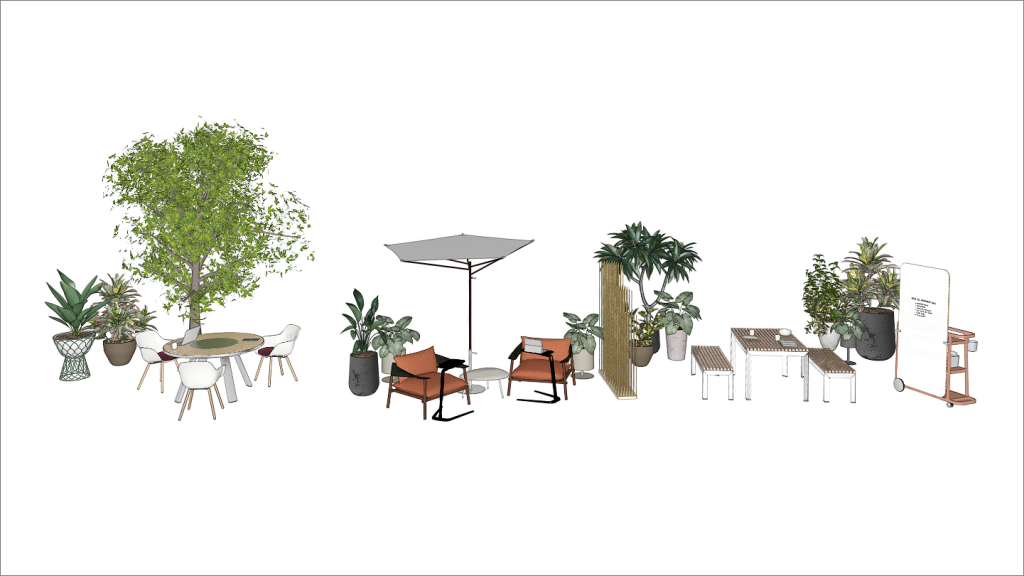
This multimodal outdoor space provides people with a change of scenery and the ability to work outside and connect with nature. The outdoor oasis supports respite and socialization. Optional temporary worktools can be used to support casual collaboration.
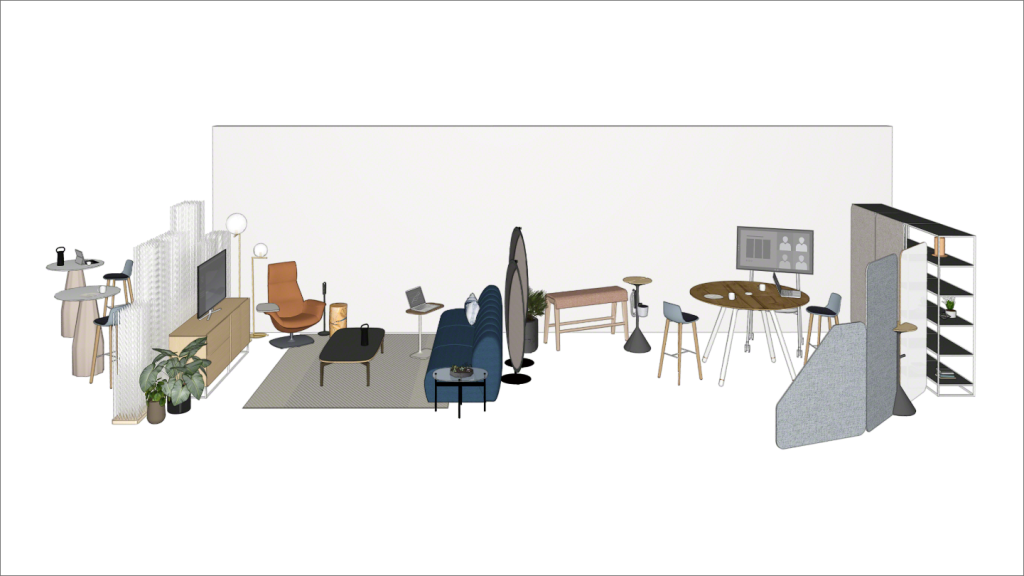
Fixed and flexible elements create a comfortable setting that supports dining and social activities. Analog and digital tools enhance performance to support collaboration.
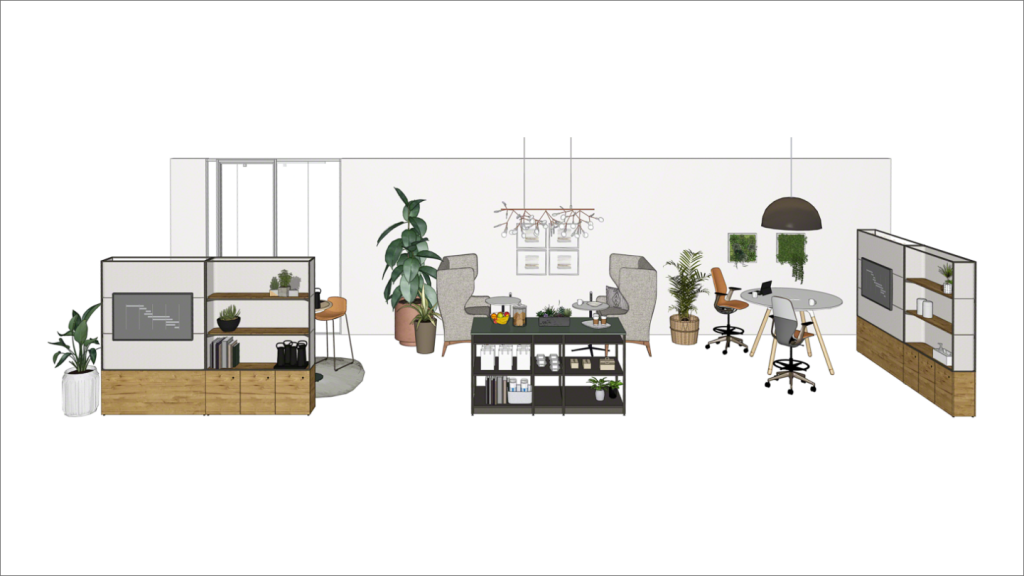
This Welcome Area is a warm, comfortable space to connect and build relationships, have coffee or a meal, or shift between meetings and breaks. Adjacent storage holds grab-and-go lunches near the main circulation path, and another serves light refreshments for customer groups across from the coffee bar. Biophilic boundary elements provide visual privacy when needed.

